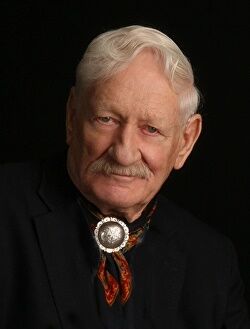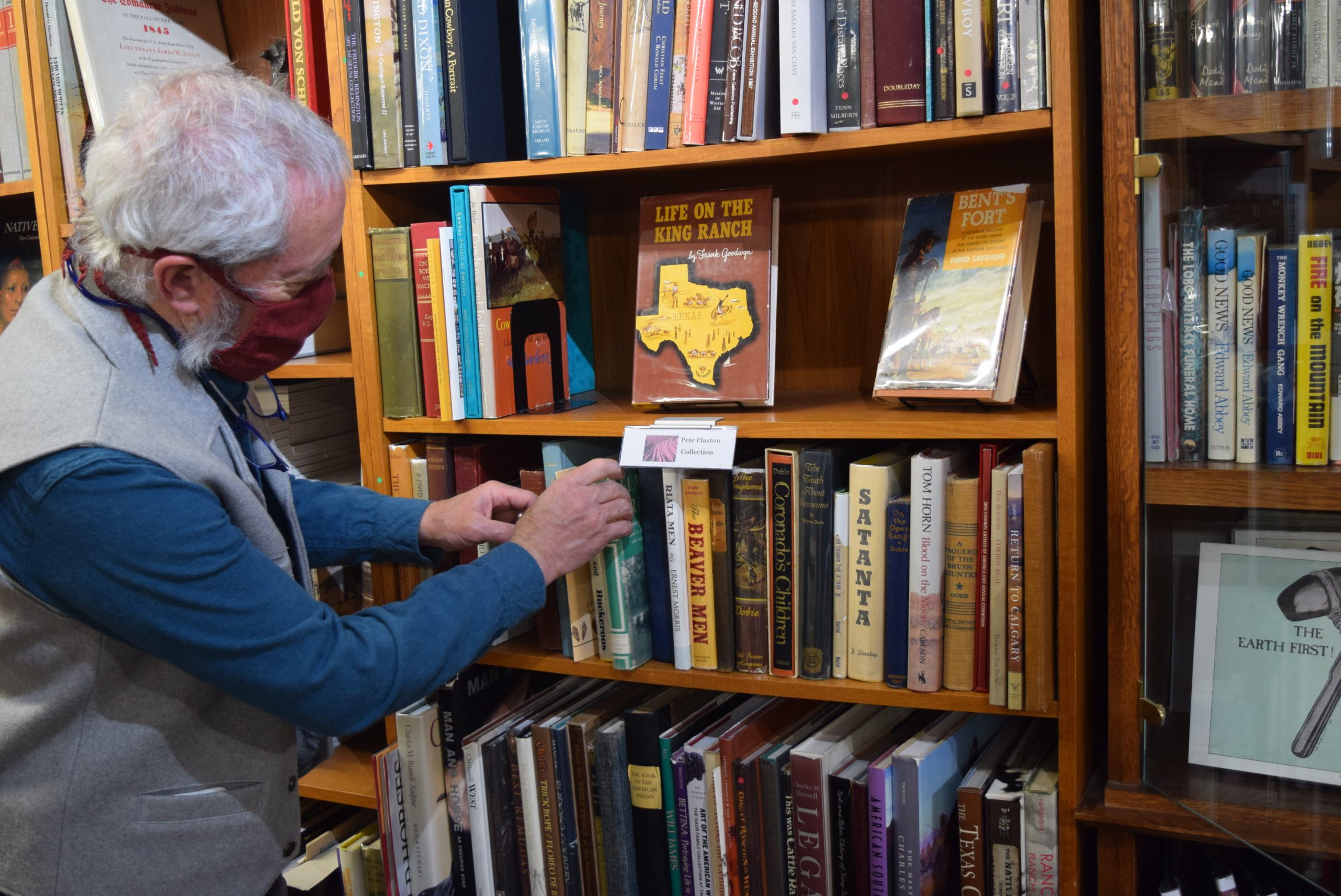Some information may be outdated.
Downtown Moab’s Back of Beyond Bookstore has a special shelf at the moment entirely dedicated to the memory and book collection of local artist Pete Plastow.
Plastow, who passed away in January of this year, was a regular client at Back of Beyond and came in once or twice a month in search of rare books that he could reference to ensure the realism of his Western American paintings. At book fairs and online auctions, Back of Beyond store owner Andy Nettell kept an eye out for the western and cowboy-themed books that Plastow sought. In Plastow’s will, he gave Nettell the first chance to acquire the collection of valuable books that he had built over decades. Nettell took the offer and bought the extensive collection. Many were volumes that Nettell had found and sold to Plastow.
“It’s beautiful. It’s like bringing back old friends,” Nettell said of purchasing the collection.
Rooted in the region

[Courtesy photo]
Plastow worked as a cowboy throughout the American West in the 1950s, then spent many years in the east working in exhibit design and construction for museums. He later returned to the west, settling in Castle Valley, where he kept a studio for painting and sculpting and gained regional recognition as a creator of Western American art. To inform his works depicting Native American and cowboy culture, he kept what some have called a “small museum” of artifacts from those cultures, as well as thousands of books that could provide him with accurate historical details.
“He wasn’t a collector as much as a user of reference books,” Nettell said of Plastow. A pure collector would try to keep a book in pristine condition to maintain its value. Plastow, in contrast, prized books for their content.
“Any time he bought a book, I knew he was going to read it, and he was going to utilize the information,” Nettell said of Plastow, describing how the artist would thumb through pages, make notes, and “always put his name right inside the cover,” adding that “collectors hate that!”
Careful study of historical sources helped Plastow correctly portray his subjects.
“If he was going to portray a Kiowa, he wanted the beadwork to be right, he wanted the dress to be right, he wanted the type of horses they rode to be correct—he would buy specifically for his artwork,” said Nettell. “I think it followed through.” When Plastow sold a painting, Nettell said, staff at the bookstore knew—because he would come in looking to buy more books.
“He always wore his cowboy hat, always had a smile,” Nettell remembered.
One author Plastow particularly loved was Will James, a cowboy who wrote western stories for both adults and children in the early 20th century. James was also an artist, and would sometimes embellish copies of his books with original artwork, a feature that makes those copies very valuable today. At a book fair in Denver several years ago, Nettell came across a dealer with a collection of Will James works, many signed, inscribed and “full of art.” The rare books were expensive, and there was no way Nettell could afford them all, so he took notes and brought a list back to Plastow, who after consideration selected the ones he most wanted Nettell to purchase for him.
“Then, of course, sadly, we got those books back,” Nettell said. Not only did the Will James books return to Back of Beyond after Plastow’s death, but in going through the collection, Nettell came across the very list of James volumes he had brought back for Plastow from the Denver book fair years ago.
“It was so bittersweet,” Nettell said. “Right in my writing was a list of Will James books, and Pete had made notes on it, unbeknownst to me.” All of Plastow’s Will James books have been sold to a dealer in Wyoming who has James-enthusiast clients, collectors who will continue to treasure the volumes.
Normally books purchased as a large collection would be separated by subject at Back of Beyond, but to honor Plastow and the personal relationship he had with staff at the store, Nettell has a shelf specifically for Plastow’s collection. The books are for sale—some have already sold—but in the meantime they’re on display for visitors.
Staff are still assessing and cataloging the large collection, and volumes will cycle through the display shelf as they are processed and sold. Nettell said when more of the books have been assessed, he’d like to invite locals to come take a look and learn about a less well-known side of Plastow’s multi-faceted character.
“So many people knew him. They knew him as an artist, I’m not sure they knew him as a book collector as much,” said Nettell.
A look inside the rare book trade
Rare and collectible books make up a substantial portion of Back of Beyond’s business. Browsers at the store can find—in addition to hiking guides, staff-recommended novels or postcards designed by local artists—high-value historic or limited-edition books, usually with an American Southwest theme. Most of Back of Beyond’s rare book trade doesn’t take place among casual shoppers at the store, however. Long-term clients, online selling platforms, and regional book fairs are the major outlets for the buying and selling of valuable books.
Nettell made his first foray into the rare book trade when he bought Back of Beyond in 2004. The previous owners had kept a display case of collectible books by iconic regional author Edward Abbey. The owners took the Abbey books home before turning the store keys over to Nettell, who felt the hole left by the removal of those volumes.
“We have a direct lineage to Edward Abbey in this store; it seemed like I had to have some Abbey books,” he said. Nettell bought a few Edward Abbey first editions to restore the emptied bookcase. A few years later, when the 2008 recession put a deep cut in new book sales, Nettell looked back to the rare book trade in search of another source of revenue to keep the store afloat. Gradually he became more involved in that side of the business, focusing on an American Southwest niche, attending rare book fairs, creating rare book catalogs, and joining the Antiquarian Booksellers Association of America. Now, the rare book trade makes up about 50% of the store’s business.
Many factors contribute to the value of a book. Age, though important, is not always the defining quality. The condition of the book is paramount—that’s why Plastow’s habit of putting his name in his books is frowned upon by collectors. Rarity of a book—for example, if it was part of a limited print run—increases its value. Books written by a famous author, even if the work itself isn’t famous or even very good, are valued by “completist” collectors, who may want copies of all the works of a specific author. Books signed or inscribed by the author, particularly if they are inscribed to another person of note, are prized. The illustrator of a certain book might increase its value. Sometimes books are especially valuable in a certain region, the way Moab residents may have a special regard for books by Edward Abbey not shared outside the region. Or, an author or type of book might surge in popularity in correlation with another trend. For example, when the novel “No Country for Old Men” by Cormac McCarthy was made into a movie, McCarthy books spiked in value.
“Sometimes there could be simply a beautiful book,” Nettell said, meaning the object itself is pleasing and commands value. “It could have gold gilt edges to it, it could have a very special leather binding, there’s a whole host of things that bookbinders can do to make a book extra special.”
Learning the nuances of the trade, and how to accurately value a book, took trial and error and a lot of experience, Nettell said. Obviously, he hopes to be able to sell books for more than he buys them for, and that can be a gamble. Having an understanding of what specific clients are looking for usually directs his purchasing. Now that Back of Beyond is established as specializing in the American Southwest, other dealers with books in that area will sometimes approach Nettell offering relevant items for sale. They’re not always books: Photographs, letters, and art can be closely affiliated with books, genres, and/or subjects of interest, and Nettell often deals with such “ephemera” in his work.
Some of those Southwest books and materials reside in the store before they’re sold. Nettell showed off a copy of what he described as “the most beautiful thing that the government has ever published”: a work of science and art called the “Tertiary History of the Grand Cañon District with Atlas,” compiled by geologist Clarence Dutton and distributed to every member of Congress in 1882. The large, heavy volume contains geological maps of the canyon, in-color topographic maps, and stunning color plates of line drawings of the canyon. A detailed triptych in warm desert tones features Point Sublime, which remains a famous vista from the rim of the Grand Canyon.
Nettell has handled other copies of the atlas before, but this particular one was not only signed by Clarence Dutton, but also inscribed with an affectionate message to John Karl Hillers, who served as a boatman and photographer to John Wesley Powell on expeditions down the Colorado River and through the Grand Canyon.
In another layer of history, the copy came from the private library of environmentalist, author and mountaineer Francis Farquhar, famous in his own right. In 1953 Farquhar published a bibliography of the 125 most important books on the Colorado River.
“To a collector of the Grand Canyon and the Colorado River, it doesn’t get any better,” Nettell said. Nettell himself is as excited about the exquisite atlas as any collector, but he says he rarely keeps books himself.
“I get almost the same joy, I think, as collectors do, by acquiring and searching down the material. I don’t really need to hold on to it,” he said.
Appreciate the coverage? Help keep local news alive.
Chip in to support the Moab Sun News.





